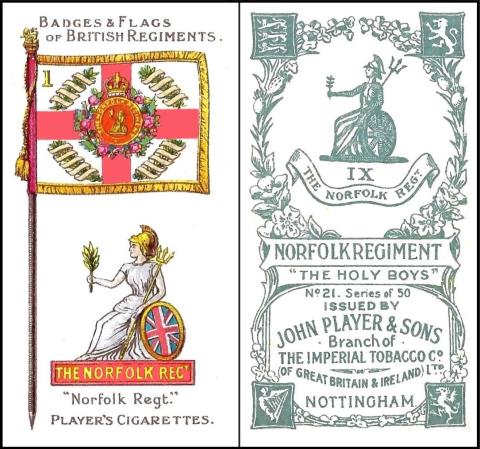
To close our week we have this, the badge and flag of the Norfolk Regiment. This infantry unit began in 1685, as Henry Cornewall`s Regiment of Foot. Despite his name, Henry Cornewall came from Herefordshire, and he was asked to start the regiment by James II, to help defeat the Monmouth Rebellion. After that it travelled widely, to Ireland, Bermuda, Holland, Portugal, Cuba, Florida, and Canada, getting renamed along the way, in 1751, as the 9th Regiment of Foot, before taking part in the American Revolutionary War, where many of its men were either killed or captured.
The prisoners were released in 1782, the same year that the story takes a surprising turn, for in August of that year the regiment was suddenly linked to Norfolk in England, and given the new name of the 9th (East Norfolk) Regiment. It did not go there, for some time, its first posting was to the West Indies, and it continued to travel the globe. It did not even have a home in Norfolk until 1873, when it was given Gorleston Barracks, in Great Yarmouth. And it only became "1st Battalion, The Norfolk Regiment" on the first of July 1881, a strange amalgamation with several assorted local volunteer battalions of local men.
After service in the First World War, but not until 1935, it was upgraded to the Royal Norfolk Regiment. And in 1959 it was amalgamated with The Suffolk Regiment to form the 1st East Anglian Regiment (also known as the Royal Norfolk and Suffolk).
This set first appears in our original John Player reference book, RB.17, published in 1950, as :
BADGES & FLAGS OF BRITISH REGIMENTS. Small cards. Fronts in colour. Backs without descriptive text.
19. 50. Brown backs
A. Numbered
B. Unnumbered20. 50. Grey Green backs
A. Thick card
B. Thin cardIssue of item 19 is generally believed to have taken place in February 1904, with Item 20 probably a year or so earlier. Messrs. Player`s records show, however, that the printing of Item 19 was issued in 1910; they have no record of Item 20.
The same 50 Regiments are covered by both series, but the badges in almost every case and flags in most cases vary, sometimes entirely and sometimes in detail only. Back formats are similar, but the cards under Item 20 carry at the four corners the national emblems of England, Scotland, Ireland and Wales. The numbering systems are entirely different. Some colour varieties are known for Item 20. An alphabetical listing for the unnumbered series under 19-B is given below, with corresponding numbers for 19-A and 20.
That will be scanned in tomorrow.
Now they are right when it says above "the badges in almost every case and flags in most cases vary, sometimes entirely.." because here is the grey green version, where it is card 21.
The first thing I noticed is that the two have an entirely different motto - our red card calling them "The Fighting Ninth", referring to their Regimental number, and the grey-green calling them "The Holy Boys". I have tracked down the origins of "The Holy Boys" and it dates from their service in the Peninsular War, in Spain, when the local people believed their badge was of the Virgin Mary rather than Britannia. However they would have more likely called them "Los Ninos Santos", or the little saints.
Look too at the flag, and our original red backed card has the Union Jack in the top corner, with the battle honours in two columns - whereas this grey green backed card shows no flag, just a number one and the battle honours in diagonal formation round what looks like a spray of laurel. The number one is important though, because if you remember from above, it was on the first of July, 1881, that they were given a new title, their former "9th Regiment" being replaced by "1st Battalion, The Norfolk Regiment".
Lastly, Britannia is on a yellow background inside a wreath, on which are the battle honours, on the red backed card, but just against a white background here on the grey-green one.
Our original World Tobacco Issues Index describes them as :
BADGES & FLAGS OF BRITISH REGIMENTS. Sm. (50). See RB.17/19-20 ... P72-17
A. Back in brown. See H.341. (a) Unnumbered (b) Numbered.
B. Back in green. Subjects mostly revised, with different numbering.
In the updated version the text reads the same, but there is a new card code, of P644-044

